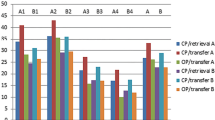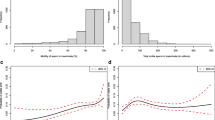Abstract
Purpose
To introduce a prognostic model for women’s assisted fecundity before starting the first IVF/ICSI treatment cycle.
Methods
In contrast to previous predictive models, we analyze two groups of women at the extremes of prognosis. Specifically, 708 infertile women that had either a live birth (LB) event in the first autologous IVF/ICSI cycle (“high-assisted-fecundity women”, n = 458) or did not succeed in having a LB event after completing three autologous IVF/ICSI cycles (“low-assisted-fecundity women”, n = 250). The initial sample of 708 women was split into two sets in order to develop (n = 531) and internally validate (n = 177) a predictive logistic regression model using a forward-stepwise variable selection.
Results
Seven out of 32 initially selected potential predictors were included into the model: women’s age, presence of multiple female infertility factors, number of antral follicles, women’s tobacco smoking, occurrence of irregular menstrual cycles, and basal levels of prolactin and LH. The value of the c-statistic was 0.718 (asymptotic 95% CI 0.672–0.763) in the development set and 0.649 (asymptotic 95% CI: 0.560–0.738) in the validation set. The model adequately fitted the data with no significant over or underestimation of predictor effects.
Conclusion
Women’s assisted fecundity may be predicted using a relatively small number of predictors. This approach may complement the traditional procedure of estimating cumulative and cycle-specific probabilities of LB across multiple complete IVF/ICSI cycles. In addition, it provides an easy-to-apply methodology for fertility clinics to develop and actualize their own predictive models.


Similar content being viewed by others
Change history
23 December 2019
The original article unfortunately contained a mistake. In Table 2, the headers “Development set” and “Validation set” were not aligned to to their sub-headers.
23 December 2019
The original article unfortunately contained a mistake. In Table 2, the headers ���Development set��� and ���Validation set��� were not aligned to to their sub-headers.
References
McLernon DJ, Steyerberg EW, Te Velde ER, Lee AJ, Bhattacharya S. Predicting the chances of a live birth after one or more complete cycles of in vitro fertilisation: population based study of linked cycle data from 113 873 women. BMJ. 2016a;355:i5735.
Tarín JJ, Pascual E, Pérez-Hoyos S, Gómez R, García-Pérez MA, Cano A. Cumulative probabilities of live birth across multiple complete IVF/ICSI cycles: a call for attention. J Assist Reprod Genet (in press).
Zegers-Hochschild F, Adamson GD, Dyer S, Racowsky C, de Mouzon J, Sokol R, et al. The international glossary on infertility and fertility care, 2017. Hum Reprod. 2017;32:1786–801.
Dhillon RK, McLernon DJ, Smith PP, Fishel S, Dowell K, Deeks JJ, et al. Predicting the chance of live birth for women undergoing IVF: a novel pretreatment counselling tool. Hum Reprod. 2016;31:84–92.
Sarais V, Reschini M, Busnelli A, Biancardi R, Paffoni A, Somigliana E. Predicting the success of IVF: external validation of the van Loendersloot’s model. Hum Reprod. 2016;31:1245–52.
Qiu J, Li P, Dong M, Xin X, Tan J. Personalized prediction of live birth prior to the first in vitro fertilization treatment: a machine learning method. J Transl Med. 2019;17:317.
McLernon DJ, Maheshwari A, Lee AJ, Bhattacharya S. Cumulative live birth rates after one or more complete cycles of IVF: a population-based study of linked cycle data from 178,898 women. Hum Reprod. 2016b;31:572–81.
Leijdekkers JA, Eijkemans MJC, van Tilborg TC, Oudshoorn SC, McLernon DJ, Bhattacharya S, et al. Predicting the cumulative chance of live birth over multiple complete cycles of in vitro fertilization: an external validation study. Hum Reprod. 2018;33:1684–95.
Modest AM, Wise LA, Fox MP, Weuve J, Penzias AS, Hacker MR. IVF success corrected for drop-out: use of inverse probability weighting. Hum Reprod. 2018;33:2295–301.
Wilkinson J, Roberts SA, Vail A. Developments in IVF warrant the adoption of new performance indicators for ART clinics, but do not justify the abandonment of patient-centred measures. Hum Reprod. 2017;32:1155–9.
Daya S. Life table (survival) analysis to generate cumulative pregnancy rates in assisted reproduction: are we overestimating our success rates? Hum Reprod. 2005;20:1135–43.
Caetano SJ, Sonpavde G, Pond GR. C-statistic: a brief explanation of its construction, interpretation and limitations. Eur J Cancer. 2018;90:130–2.
Hosmer DW, Lemeshow S, Sturdivant RX. Applied logistic regression. 3rd ed. New Jersey: John Wiley and Sons, Inc.; 2013.
Tarín JJ, Pascual E, García-Pérez MA, Gómez R, Cano A. Women’s morbid conditions are associated with decreased odds of live birth in the first IVF/ICSI treatment: a retrospective single-center study. J Assist Reprod Genet. 2019;36:697–708.
van Loendersloot LL, van Wely M, Repping S, Bossuyt PM, van der Veen F. Individualized decision-making in IVF: calculating the chances of pregnancy. Hum Reprod. 2013;28:2972–80.
Author information
Authors and Affiliations
Corresponding author
Ethics declarations
This study was approved by the Ethical Committee of Clinical Investigation, Valencia University Clinical Hospital, on November 30 2017 (2017/316).
Additional information
Publisher’s note
Springer Nature remains neutral with regard to jurisdictional claims in published maps and institutional affiliations.
The original version fo this article was revised: In Table 2, the headers "Development set" and "Validation set" were not aligned to its sub-header.
Rights and permissions
About this article
Cite this article
Tarín, J.J., Pascual, E., García-Pérez, M.A. et al. A predictive model for women’s assisted fecundity before starting the first IVF/ICSI treatment cycle. J Assist Reprod Genet 37, 171–180 (2020). https://doi.org/10.1007/s10815-019-01642-3
Received:
Accepted:
Published:
Issue Date:
DOI: https://doi.org/10.1007/s10815-019-01642-3




